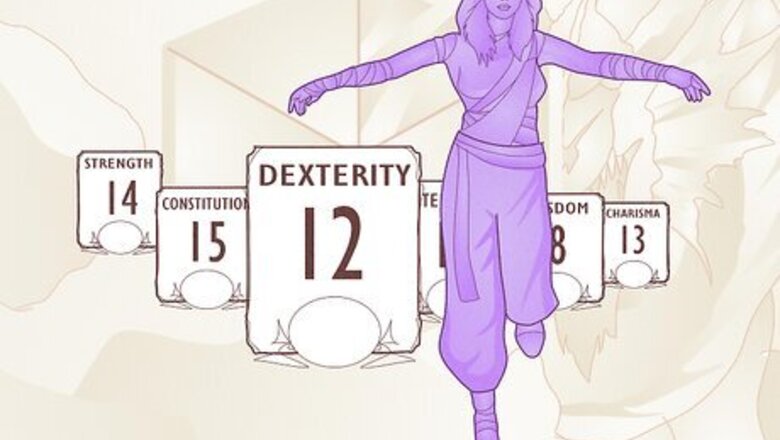
views
- Dexterity is one of six ability scores (along with Strength, Constitution, Intelligence, Wisdom, and Charisma). It gauges a character’s agility, reflexes, and balance.
- A character’s Dexterity (DEX) ability score also determines their DEX modifier, which is a value used to calculate skill checks, saving throws, and attack rolls.
- Dexterity also factors into mechanics like a character’s Armor Class (which impacts how hard they are to hit) and Initiative (which sets the order of turns in a battle).
What is Dexterity?
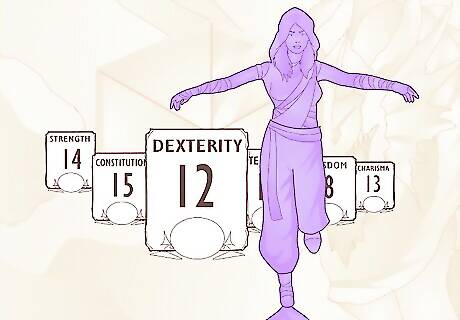
Dexterity determines a character’s agility, reflexes, and balance. In D&D 5e, Dexterity (DEX) is one of the 6 core ability scores (attributes) that define a character’s natural capabilities. Along with agility, it also measures a character’s fine motor skills and hand-eye coordination. The higher a character’s DEX score, the more agile they are. Dexterity also affects a number of different mechanics in the game, including Armor Class, initiative, skills, and ability checks. All 6 primary ability scores include: Strength, Dexterity, Constitution, Intelligence, Wisdom, and Charisma.

DEX scores are determined during character creation. When you create a new player character (PC) in D&D, you’ll need to assign their ability scores—including Dexterity. There are several ways to determine a DEX score; many players use the manual method, which involves rolling 4d6, subtracting the lowest roll, then adding the rest to get each ability score. Other popular ways to determine ability scores include the point buy and standard array systems. Having a higher Dexterity score is often important for classes like bards, monks, rangers, rogues, and warlocks—as well as fighters and paladins, if they take a DEX-based approach instead of Strength-based.
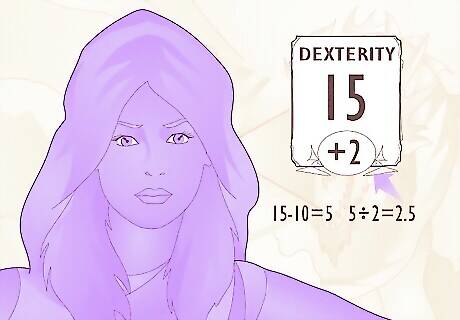
DEX modifiers are used to calculate checks and saving throws. Every PC has a Dexterity modifier that’s based on their DEX score. Modifiers are the values that you can add to rolls throughout the game—including attack rolls, certain ability and skill checks, initiative rolls, and DEX saving throws. Depending on your PC’s DEX score, their modifier could be anywhere from -5 to +10. To find your PC’s DEX modifier, simply subtract 10 from their DEX ability score and then divide the total by 2, rounding down the result. For example, if your PC’s DEX score was 15, then their modifier would be +2 (since 15 - 10 is 5, and 5 ÷ 2 is 2.5, rounded down to 2). You can also check the Basic Rules for D&D 5e if you’re unsure what your character’s DEX modifier should be.
Dexterity Ability Checks

The DM may call for a general DEX roll rather than a specific skill check. In D&D 5e, ability checks are essentially d20 rolls that test a PC’s ability to do an action or task. Many ability checks are linked to skills, like Stealth or Acrobatics (as mentioned below). However, some checks are only related to a PC’s ability score, and not a specific skill. When an action you want to take would rely on Dexterity but doesn’t really apply to one of the standard DEX-based skills, your DM might ask you to make a Dexterity check. To make a Dexterity check, simply roll a d20 (20-sided die) and add your PC’s DEX modifier to the result. For example, if another player suddenly tossed something to your PC, you might be asked to roll a Dexterity check to see if they’re quick enough to catch it.
Dexterity Skill Checks
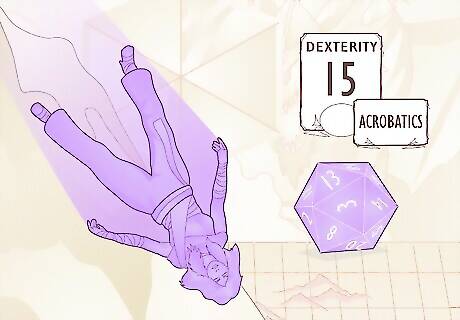
Acrobatics Acrobatics gauges a PC’s ability to perform nimble, acrobatic stunts that require a great deal of balance, speed, and coordination. Your DM might ask you to roll an Acrobatics check to navigate an unstable surface, land gracefully from a fall, or slip out of restraints. You can also use Acrobatics to escape an enemy’s grapple attack. For example, if your PC falls from a 2-story building and you want them to land without taking damage, your DM might ask you to roll an Acrobatics check to see if they’re nimble enough.

Sleight of Hand The Sleight of Hand skill is all about manual trickery. It measures a PC’s ability to pull off physical tricks like pickpocketing, stealing objects from a shop, cheating in a card game, casting spells without being detected, and subtly planting objects on people. You’ll often roll Sleight of Hand checks against other creature’s passive Perception scores. Perception is a skill that measures a creature’s awareness of their surroundings. Thus, if you succeed on your Sleight of Hand check and beat the other creature’s passive Perception score, you’ll successfully pull of your act of trickery.

Stealth The Stealth skill determines a PC’s ability to hide, move around silently, and generally avoid being noticed by others. You might make a Stealth check when scouting an enemy’s lair, hiding from guards, or creeping up behind someone to try and perform a sneak attack. Normally, you roll Stealth checks against other creatures’ passive Perception scores—and if you succeed, they won’t notice your PC’s movements. However, if a creature is actively looking for your PC, you’ll roll a Stealth check against their (Wisdom) Perception check, with the higher roll being the winner. Passive Perception refers to a creature’s unconscious awareness, while Perception checks measure a creature’s ability to actually detect things in their environment.
Dexterity in Combat
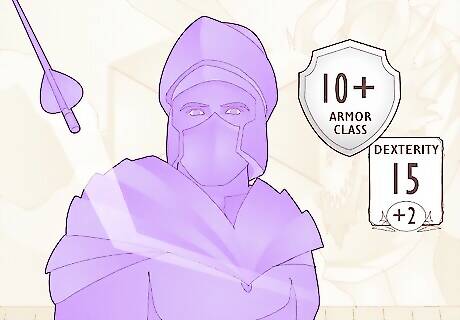
Armor Class (AC) Armor Class is a mechanic that determines how well-protected (and difficult to hit) a creature is. The higher your AC, the harder it is for enemies to hit you. Your PC’s armor class is 10 + their DEX modifier by default; however, this can change depending on the type of armor they wear. Certain types of armor limit how much your PC’s DEX modifier can influence their armor class. For example, if your PC’s DEX modifier was +3, then their base AC without any armor equipped would be 13. Light armor (like leather, studded leather, and padded armor) allows PCs to add their full DEX modifier to their armor class. Medium armor (like scale, breastplate, and hide armor) allows PCs to add their DEX modifier to their AC to a maximum of +2. So, if your PC had a +3 modifier but wore medium armor, they could only add +2 to their AC. Heavy armor (like chain, splint, and plate armor) is not affected by Dexterity at all; while wearing heavy armor, you can’t add your PC’s DEX modifier to their armor class. Therefore, a high DEX modifier (and score) is important to PCs who wear light armor or no armor at all but fairly unimportant to PCs who wear heavy armor.
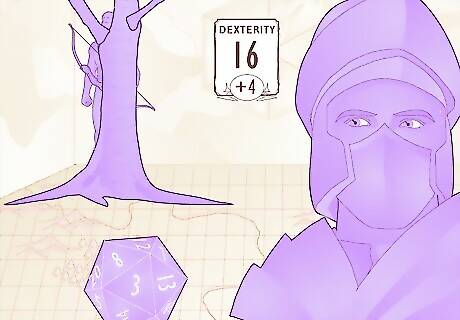
Initiative Initiative is a mechanic used to determine the order in which characters take their turns during battles. Each combatant must make an initiative roll—which means rolling a d20 and adding your PC’s DEX modifier to the result. Since initiative essentially measures a character’s ability to react fast and jump into action, Dexterity is the ability score that affects initiative rolls. For example, if your PC has a +4 DEX modifier, their initiative modifier is also +4 (unless you have a feature, like the Alert feat, that grants an additional bonus). So, if your PC had to roll for initiative and got a 12 on their d20, then their total initiative would be 16 (since 12 + 4 = 16).

Weapon attack and damage rolls Finesse and ranged weapons allow PCs to use their Dexterity modifier for attack and damage rolls rather than their Strength modifier. This means that when making an attack roll, you’d roll a d20 and add your PC’s DEX modifier (and proficiency bonus, if applicable). Then, when calculating damage, you’d add your PC’s DEX modifier to the damage roll. Finesse weapons include rapiers, shortswords, daggers, scimitars, and whips. Ranged weapons include shortbows, longbows, crossbows, slings, and darts. If you have a PC with a high Dexterity and low Strength score, it’s a good idea to equip them with finesse or ranged weapons when possible.

Saving throws Saving throws are rolls made to resist negative effects—like spells, traps, poisons, diseases, or even attempts at mind control. Typically, DMs ask for a Dexterity saving throw when a character needs to try and dodge a hazard or spell quickly. Along with Constitution and Wisdom saving throws, DEX saves are some of the most common (and important) in the game. Lots of powerful area-of-effect spells like Fireball, Ice Storm, Flame Strike, Chain Lightning, and Earthquake require targets to make DEX saving throws. For example, say an enemy wizard cast Fireball at your PC. You’d have to make a DEX save to avoid the flames; if you passed the saving throw, your PC would take half damage, and if you failed, they’d take full damage.















Comments
0 comment